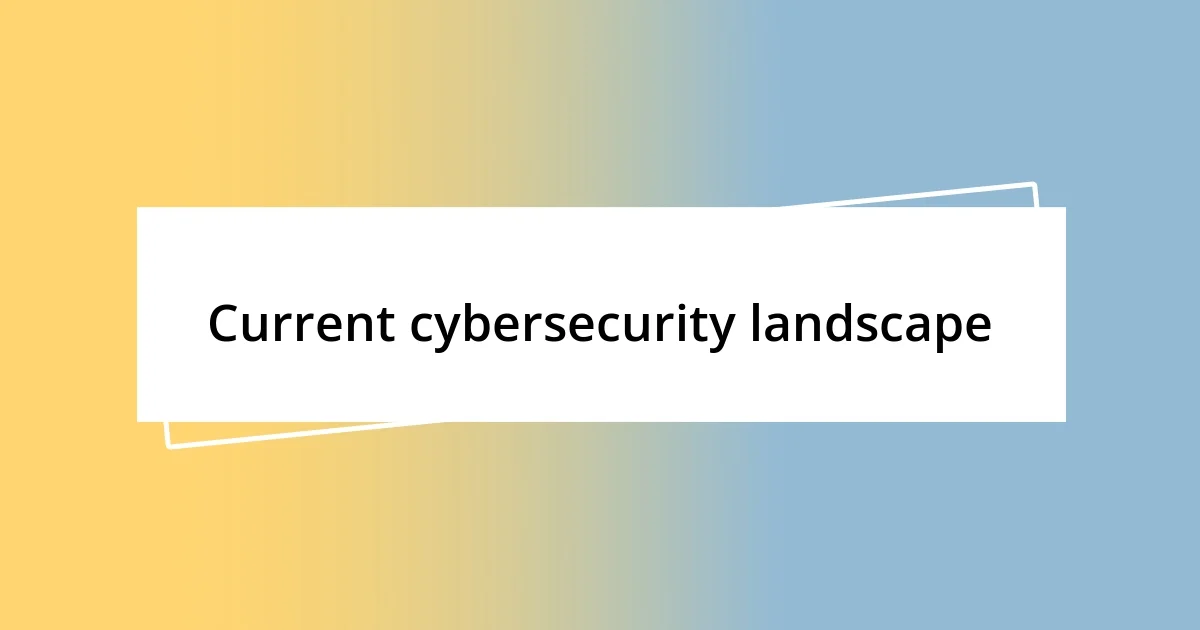Key takeaways:
- The cybersecurity landscape is rapidly evolving, with increased threats such as ransomware, deepfake technology, and IoT vulnerabilities necessitating heightened awareness and comprehensive security measures.
- Employee training is crucial for building a proactive cybersecurity culture, transforming employees into vigilant defenders and reducing security incidents through knowledge and engagement.
- Regulatory changes are reshaping security practices, driving organizations towards better compliance and innovation in cybersecurity strategies, while future trends indicate a move towards zero trust architecture and increased collaboration against cyber threats.

Current cybersecurity landscape
As I navigate the current cybersecurity landscape, I often feel a mix of urgency and unease. Just last month, a friend of mine experienced a ransomware attack that locked her out of her business data overnight. It was a stark reminder that threats are evolving rapidly, and it made me wonder—how prepared are we really for the next wave of cyberattacks?
The rise of remote work has dramatically shifted the way we think about security. I recall my own experience trying to secure my home network; it was eye-opening to realize how vulnerable even the smallest connection can be. This trend has pushed organizations to reconsider their cybersecurity measures, as many employees now access sensitive information from less secure environments.
Data breaches are now an almost daily headline, making it clear that no one is immune. I often ask myself, why is it that despite all the advancements, we seem to be falling behind? Cybercriminals are employing increasingly sophisticated tactics, and the emotional toll on victims—whether individuals or businesses—can be staggering. It’s not just about financial loss; it’s about trust, reputation, and the sense of safety we once took for granted.

Emerging threats in cybersecurity
Emerging threats in cybersecurity are becoming alarmingly sophisticated. For instance, I recently attended a cybersecurity conference where professionals highlighted the rise of deepfake technology. Just thinking about how easily someone could impersonate a trusted source sends shivers down my spine. It’s not just about hacking anymore; verifying identities has become a labyrinthine task where traditional checking methods might no longer suffice.
Another trend that captures my attention is the surge in IoT (Internet of Things) vulnerabilities. As I’ve integrated smart home devices into my own life, I couldn’t shake the anxious feeling that I’ve opened multiple gateways for potential attacks. I wonder how many others are blissfully unaware of the security holes in their Wi-Fi-connected devices. The convenience can overshadow the risks, making awareness crucial.
Then there’s the insidious rise of supply chain attacks, which often go unnoticed until it’s too late. When I discovered that a popular software I used had been compromised, it felt like a punch to the gut. These attacks underscore the need for a comprehensive approach to security, as it’s no longer just about protecting one’s own digital assets but also ensuring the integrity of entire networks.
| Threat Type | Description |
|---|---|
| Deepfake Technology | Use of AI to create realistic fake media to impersonate individuals or manipulate information. |
| IoT Vulnerabilities | Security weaknesses in connected devices that can be exploited by attackers. |
| Supply Chain Attacks | Cyberattacks that target weaker links in the supply chain, compromising multiple organizations. |

Importance of employee training
Employee training is often the first line of defense in an organization’s cybersecurity strategy. I’ve seen firsthand how effective training can transform a group of employees from potential vulnerabilities into vigilant defenders. For instance, after a training session at my workplace, I noticed a palpable shift; my colleagues were more aware of phishing attempts and suspicious emails, which ultimately led to a decrease in security incidents. It’s fascinating how knowledge can instill confidence and encourage proactive behavior.
- Regular training sessions ensure that employees are up-to-date on the latest security practices.
- Interactive training methods, such as simulations, can help employees recognize threats in real-time.
- Creating a culture of security awareness impacts every level of the organization, fostering teamwork in protecting sensitive information.
In my experience, training isn’t just about compliance; it cultivates an engaged workforce. When employees understand the risks and their role in countering them, they tend to take ownership of security measures. For example, during a recent workshop I facilitated, one participant shared how they had identified a potential security gap in their department and took the initiative to address it. This kind of engagement is crucial—it transforms the narrative from “it’s IT’s problem” to “we’re all in this together.”
- Empowering employees through training helps build a resilient organization capable of withstanding threats.
- Incorporating real-life scenarios can make training more relatable and impactful.
- Continuous education is vital; the threat landscape is constantly changing, and so should our knowledge.

Adopting advanced security technologies
Embracing advanced security technologies has become essential in today’s digital landscape. I remember the first time I witnessed a demo of AI-driven threat detection software. The speed and accuracy with which it identified vulnerabilities left me in awe. How can we ignore such advancements when they offer a proactive approach to combating cyber threats?
More organizations are now turning to automation and artificial intelligence to bolster their defenses. The idea that machines can learn patterns and anomalies makes me think about the traditional methods we once relied on. It’s almost like having a virtual security guard that never sleeps. I’ve seen firsthand how implementing these technologies can drastically reduce response times, giving teams a fighting chance against threats that emerge at lightning speed.
Integrating new technologies also fosters a culture of vigilance. I feel a renewed sense of security knowing that cutting-edge solutions are actively working in the background. It’s like having that trusted friend who always looks out for you. As we adopt these advancements, the question arises—are we prepared to adapt our processes accordingly? From my experience, a blend of innovation with continuous education ensures we don’t just keep up but stay ahead of emerging threats.

Regulatory changes affecting cybersecurity
Regulatory changes in cybersecurity are significantly reshaping how organizations approach their security protocols. For example, I remember when the General Data Protection Regulation (GDPR) came into force in the EU. The ripple effects were felt globally, as companies scrambled to ensure compliance. It was enlightening to see how such regulations encouraged a more robust focus on data protection, pushing organizations to rethink their strategies for safeguarding customer information.
In addition, new regulations like the Cybersecurity Maturity Model Certification (CMMC) have set specific requirements for federal contractors in the U.S. Personally, I observed a client’s team undergo extensive changes to meet these standards. The commitment to securing sensitive information led to a surge in awareness and investment in cybersecurity practices across their entire workforce. Have you ever considered how regulatory compliance can actually drive innovation in security solutions? From my perspective, it often places organizations in a position to adopt best practices that they might have otherwise overlooked.
Moreover, as these regulations evolve, organizations are faced with the challenge of keeping their security measures up-to-date while meeting compliance requirements. I once participated in a compliance audit that revealed several overlooked vulnerabilities, highlighting the need for constant vigilance and adaptation. Isn’t it fascinating how regulatory frameworks can act both as a challenge and a catalyst for improvement in cybersecurity? This dual role keeps organizations on their toes, ensuring they prioritize security at every level, which ultimately benefits everyone involved.

Future predictions for cybersecurity trends
As I look ahead, one prominent trend I foresee is the increasing reliance on zero trust architecture. This framework assumes that threats could exist both inside and outside an organization, which means no one is trusted by default. Reflecting on my own experiences, I’ve often found that a layered security approach, akin to having multiple doors to get through before reaching a room, can significantly reduce the chances of a breach. It’s exciting to think how this mindset shift can change the game for cybersecurity.
In addition, the rise of remote work will likely continue to shape how security protocols are developed. I remember working with a team spread across multiple continents, and it struck me how vital it was to ensure robust security measures for everyone, regardless of their location. Have you ever thought about how this hybrid work model could expose new vulnerabilities? It certainly makes me contemplate the importance of educating employees on cybersecurity practices as part of their daily routine, fostering a collective responsibility among all team members.
Lastly, I suspect we’ll witness a marked increase in collaborative efforts between organizations, governments, and even tech firms to combat emerging cyber threats. The interconnectedness of today’s digital environment reminds me of the old saying: “Together we’re stronger.” I can’t help but feel optimistic about how pooling resources and intelligence can create a more resilient cybersecurity landscape. Does it not seem that collaboration is the key to staying one step ahead in an ever-evolving threat environment?













